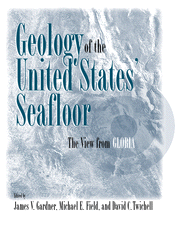Book contents
- Frontmatter
- Contents
- Contributors
- Foreword
- Introduction
- Part I The GLORIA System and Data Processing
- Part II U. S. East Coast EEZ
- Part III Gulf of Mexico and Caribbean EEZ
- Introduction
- 5 Breaching the Levee of a Channel on the Mississippi Fan
- 6 Morphology of Carbonate Escarpments as an Indicator of Erosional Processes
- 7 Sedimentary Processes in the Salt Deformation Province of the Texas-Louisiana Continental Slope
- 8 Sedimentary Processes in a Tectonically Active Region: Puerto Rico North Insular Slope
- 9 A Review of the Tectonic Problems of the Strike-Slip Northern Boundary of the Caribbean Plate and Examination by GLORIA
- Part IV U. S. West Coast EEZ
- Part V Alaskan EEZ
- Index
8 - Sedimentary Processes in a Tectonically Active Region: Puerto Rico North Insular Slope
Published online by Cambridge University Press: 25 January 2010
- Frontmatter
- Contents
- Contributors
- Foreword
- Introduction
- Part I The GLORIA System and Data Processing
- Part II U. S. East Coast EEZ
- Part III Gulf of Mexico and Caribbean EEZ
- Introduction
- 5 Breaching the Levee of a Channel on the Mississippi Fan
- 6 Morphology of Carbonate Escarpments as an Indicator of Erosional Processes
- 7 Sedimentary Processes in the Salt Deformation Province of the Texas-Louisiana Continental Slope
- 8 Sedimentary Processes in a Tectonically Active Region: Puerto Rico North Insular Slope
- 9 A Review of the Tectonic Problems of the Strike-Slip Northern Boundary of the Caribbean Plate and Examination by GLORIA
- Part IV U. S. West Coast EEZ
- Part V Alaskan EEZ
- Index
Summary
Abstract
GLORIA long-range sidescan sonar data extending from the shelf edge north of Puerto Rico across the insular slope to the floor of the Puerto Rico Trench reveal numerous canyons, amphitheater-shaped scarps, and sediment ponds. Interpretation of these data, in light of previously collected geophysical and sample data, indicates that tectonic forces have played a major role in the depositional and erosional history of the study area. Regional northward tilting of the flat, shallowwater Tertiary carbonate bank north of Puerto Rico created the insular slope and set the stage for the development of submarine canyons. The distinctive morphology of these canyons can be attributed to the character of the strata into which they have been cut. The front of the former carbonate bank has been eroded by large-scale mass wasting, which has left large amphitheater-shaped scarps on the lower slope. Shelf-derived sediment, along with material eroded from the canyon walls, is transported through the canyons to the basin and ridge province at the base of the slope where most sediment is trapped in basins south of the trench floor. The discovery of a depositional lobe on the trench floor confirms the presence of a turbidite entry point and suggests that some sediment reaches the trench floor as well.
Introduction
The deepest part of the Puerto Rico Trench, which has depths in excess of 8,000 meters (m), lies 150 km north of the island of Puerto Rico (Figure 8–1).
- Type
- Chapter
- Information
- Geology of the United States' SeafloorThe View from GLORIA, pp. 123 - 134Publisher: Cambridge University PressPrint publication year: 1996



